Penne with Creamy Guanciale Sauce
Penne with Creamy Guanciale Sauce – Penne pasta tossed with a creamy sauce made with guanciale (or pig jowls), garlic, sun-dried tomatoes, and sage.
So, I’m watching people cook on television last weekend, right? It’s a couple that does Italian recipes. Tuscan to be exact. It’s a show that I watch from my DVR so that I can skip through the scripted/staged/fake parts and just get the recipes.
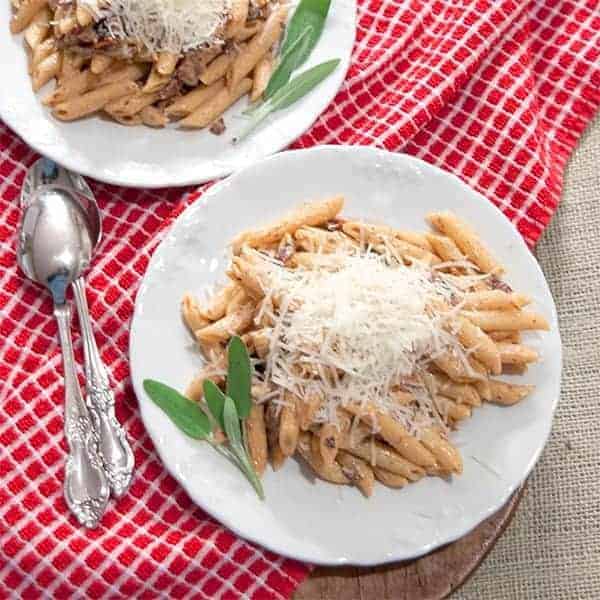
The couple started making a recipe called Pasta alla Gricia and my mouth literally starts to water. This is, apparently, a classic Tuscan recipe with the primary components of guanciale and sage tossed with pasta. Oh, yeah.
What is “Guanciale?”
Now, in case you’re not familiar with guanciale, it’s an Italian pork product that is the cured cheek of a pig. (Don’t make that face…it’s ‘gourmet’). The only problem is that it’s pretty hard to find in the U.S. unless you live in a huge metro area with a big Italian population. I happen to not.
But you can purchase it online if you’re a Rockefeller. I found it online for $74.98 per pound. Shipping extra. Yikes.
Ever Heard of Pig Jowls?
So, I started thinking. And do you know what? Pigs’ cheeks, or guanciale, are exactly the same thing that we Southerners call jowls. Some say pig jowls, some say hog jowls…all the same thing.
And as far as I can tell, the biggest difference between southern jowls and gourmet Italian guanciale is that jowls are smoked and guanciale is not. They’re both cured, but the southern version is taken one step further with the smoking.
(I’m sure somebody will quickly step in to correct me and fill me in on all the fine points of guanciale making and how it’s vastly superior to southern pig jowls. Whatever. It’s all lard.)
And guess what else. Jowls are about $3.49 a pound. Even cheaper in little country grocery stores. And I’ve been eating them all my life.
They’re a vital part of the traditional Southern New Year’s dinner. And there’s not a grocery store in the southeastern U. S. that doesn’t have some on its shelves. Every day.
Needless to say, I used my southern hog jowls to make this classic Italian recipe. I also added a few things that aren’t part of the classic recipe…of course.
If you have access to guanciale, go ahead and use that, but if the nearest authentic Italian market is a plane ride away, you might enjoy this recipe with that bit of smoky flavor that comes from the jowl ;-)
How to Make Penne with Creamy Guanciale Sauce
Cook the pasta in a large pot of salted, boiling water according to the package directions.
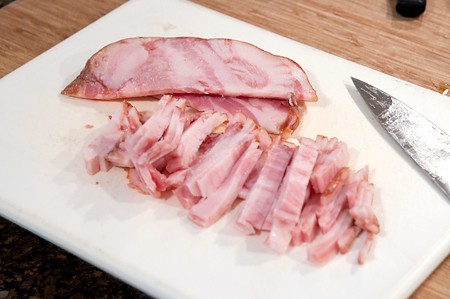
Prepare the guanciale or pig jowls by cutting it crosswise into thin strips. Note: if your guanciale or jowls are not already sliced, slice them into strips (like bacon) before cutting crosswise.
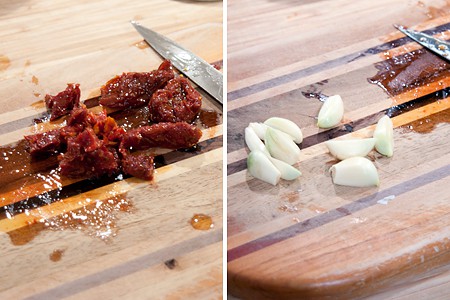
Dice the sun-dried tomatoes and cut the peeled garlic cloves in half.
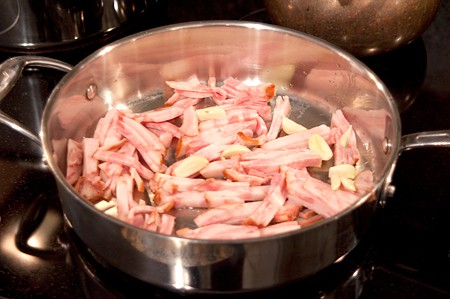
While the pasta cooks, in a large skillet or saucepan, heat the olive oil over medium heat. Add the guanciale or jowls, sun-dried tomatoes, and garlic. Cook, stirring, for about 10 minutes.
Be careful not to let the guanciale burn or the garlic get too brown. If you think the garlic is browning too fast, you can remove it from the pan and add it back when finishing the sauce.
When the guanciale is nicely browned, drain away all but about 2 tablespoons of fat from the pan. Believe me, there is going to be a lot of fat in the pan. Most recipes I’ve seen don’t mention draining away the fat but I can’t imagine leaving all that lard to coat the pasta. If you want to leave it, okay, but I’ll drain mine. Thank you.
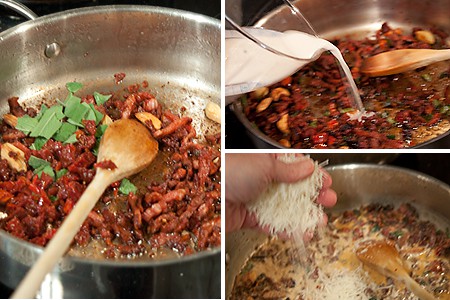
Discard the fat and return the pan to the heat. Add the sage and cook, stirring for 1 minute. Add the half and half, pepper, and Pecorino cheese. Stir just until the cheese is melted.
Drain the pasta, reserving some of the water. Add the pasta to the skillet with the guanciale sauce. Toss to coat the pasta with the sauce. Add some of the reserved cooking water to thin the sauce if needed. Taste and add additional pepper if desired.
Serve with additional grated Pecorino and a drizzle of extra-virgin olive oil.
🧾 More Recipes You’ll Like
- Pasta d’Arrabiata
- Creamy Ham and Red Bell Pepper Pasta
- Bacon, Lettuce and Tomato (BLT) Pasta
- Bow Tie Pasta Salad with Tomatoes and Grapes

Questions? I’m happy to help!
If you have more questions about the recipe, or if you’ve made it and would like to leave a comment, scroll down to leave your thoughts, questions, and/or rating!
Thanks so much for stopping by!
Want to save this recipe?
Enter your email below and get it sent straight to your inbox.
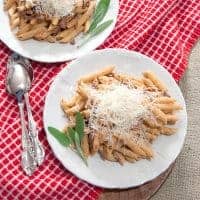
Penne with Creamy Guanciale Sauce
Ingredients
- 1 pound penne pasta
- 1 tablespoon olive oil
- 8 ounces guanciale or southern style pig jowls cured pig cheeks, sliced into thin strips
- ¼ cup chopped sun-dried tomatoes in oil
- 5 cloves garlic halved
- 6 fresh sage leaves
- ½ cup Half and Half
- 1 cup grated Pecorino cheese
- ½ teaspoon ground black pepper
- ¼ cup extra-virgin olive oil
Instructions
- Cook the pasta in a large pot of salted, boiling water according to the package directions.
- While the pasta cooks, in a large skillet or saucepan, heat the olive oil over medium heat. Add the guanciale, sun-dried tomatoes, and garlic. Cook, stirring, for about 10 minutes. Take care not to let the guanciale burn or the garlic get too brown. If you think the garlic is browning too fast, you can remove it from the pan and add it back when finishing the sauce.
- When the guanciale is nicely browned, drain all but about 2 tablespoons of fat from the pan. Discard the fat and return the pan to the heat. Add the sage and cook, stirring for 1-2 minutes. Add the half and half, pepper, and Pecorino cheese. Stir just until the cheese is melted.
- Drain the pasta, reserving some of the water. Add the pasta to the skillet with the guanciale sauce. Toss to coat the pasta with the sauce. Add some of the reserved cooking water to thin the sauce if needed. Taste and add additional pepper if needed.
- Serve with additional grated Pecorino and a drizzle of extra-virgin olive oil.
Notes
Nutrition Information
Nutrition information is calculated by software based on the ingredients in each recipe. It is an estimate only and is provided for informational purposes. You should consult your healthcare provider or a registered dietitian if precise nutrition calculations are needed for health reasons.
More Guanciale Recipes …
- Authentic Spaghetti alla Carbonara from The Kitchn
- Homemade Pasta with Sun-Dried Tomatoes and Guanciale from Lemons and Anchovies
- Stir-Fried Chard with Guanciale and Onions from Market Manila
- Spaghetti with Guanciale and Cheese from Tasting Table

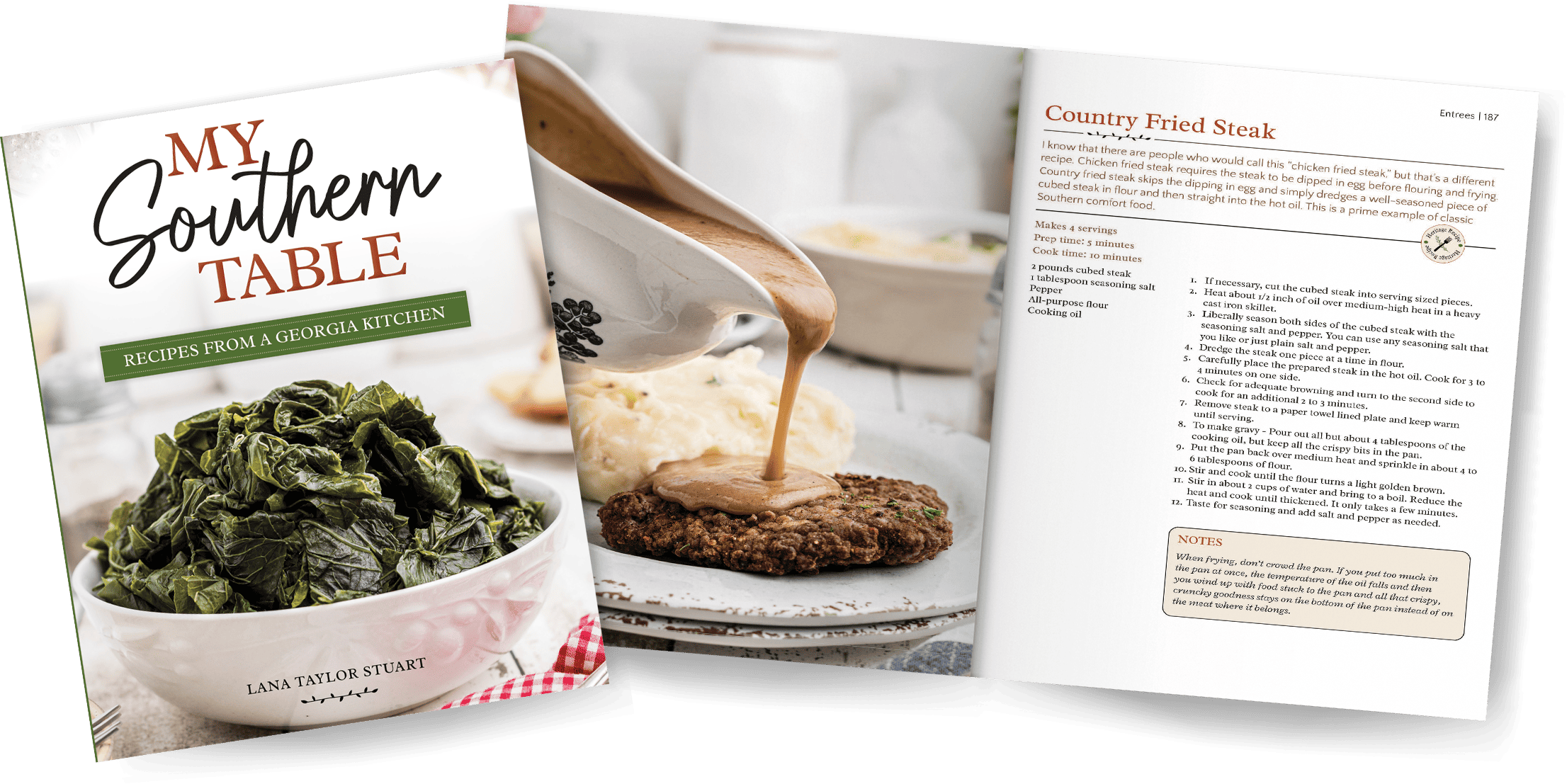
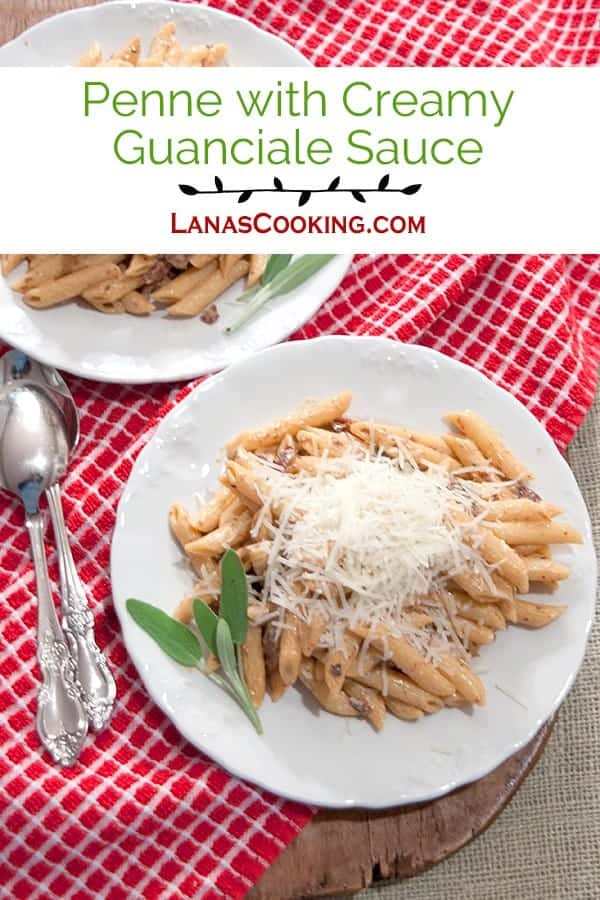
I could eat pasta everyday! I’ve never cooked with pig jowls before… you’re always giving me a great challenge, Lana! xo
I could, too, Kelly. I love pasta and I love pork so this was a win-win for me!
Looks amazing! My husband will love this. I must make asap.
I hope you and he like it!
Please inquire of Pamela as to where she resides. I just have to know. Regional cuisines are fascinating. Hog Maw. I have never heard of that before. I wonder if the name is related to “mull”?
This looks very good and very rich.
Miss P
According to Google, it’s a Pennsylvania Dutch recipe. Never heard of it, either!
In response to your question the dish known as “hog maw” IS a more Pennsylvania Dutch type of dish although I do live in Maryland even if it’s only about 5 miles across the state line. (actually I live approximately 7 miles from Camp David, yes, THAT Camp David if you happen to know where it is). This would be a more local dish as I can guarantee you on the eastern shore you won’t find this. This is the crazy thing here in Maryland, especially in the area where I live as we’re so close to several different states. The word “maw” actually means mouth or intake but has also been extended to mean stomach and that’s exactly what is being used here. Now before you go “Ewwwww” and think it’s something terrible I have to say in all my years as an adult I have never served this to anyone (including quite a few boyfriends) who didn’t like it. Basically, if you like sausage, potatoes and onions you’ll enjoy this meal. This is the advantage of not adding all that other stuff some families do. However, you can’t just put these three ingredients together and get the same thing, stuffing it into the maw adds another flavor that just can’t be replicated. If you ever want to try this many GOOD butcher shops can obtain one for you but you MUST request that it be cleaned. Trust me, you do NOT want to get one you have to clean yourself. You also should have kitchen string (same thing you use to truss a turkey or chicken) and a VERY large sewing needle (culinary needles can be purchased online and I’ve been wanting to do so soon)is required, one with an eye large enough for the string. This cleaned maw will have two main openings, one large, one small. Go ahead and sew closed the small hole. Then, after you cube approximately 10 lb of potatoes, 5 lbs of onions (10 or 15 if you were my grandmother) and have 5 lbs of loose sausage (the sausage can make or break how good it is, our family has a preference for the sausage from a particular source – Hoffman’s Sausage in our area). Thoroughly mix three three ingredients together, season with salt and pepper and begin stuffing it in the maw. Extra hands can be a help here, especially if you’re a beginner. Now remember, this maw will stretch (remember, this IS a stomach after all) and you want to keep stuffing and stuffing as much as you can. Then, sew closed the opening. Again here a helper can be good. The needle will become very slippery since you’re pushing it through pork and a clean dish cloth will help here to grab the needle. Also wearing clean kitchen or rubber gloves helps keeps hands clean. If you don’t want to sew there is a trick I learned in a pinch making this at someone else’s home before. Wrap the maw VERY tightly in aluminum foil will keep it closed. In fact, you want to wrap any maw tightly in foil before roasting. A sign of a well roasted maw is that it doesn’t bust during roasting. Roast in a 350 degree oven approximately 3 to 5 hours depending on the size of the maw. Make sure you keep about an inch or two at least of water in the bottom of the roaster so it doesn’t burn. Some people eat the maw, some don’t. The areas where it gets brown and crispy are the best.
When my mom does them for family dinners she usually does at least 2, sometimes even 3 at a time as everyone wants to take leftovers home with them. I’ve arrived at my parent’s home before over the years and can smell them all the way in the driveway. To many people it’s better than any steak or roast. We always serve cole slaw (finely shredded is our preference) and a baked corn casserole I started making many years ago, almost like a corn pudding actually. One year in college I was driving back to college and in the car with me was what I thought was a big yellow bowl of leftover hog maw. My mouth literally watered the entire way home. Now this is LONG before the days of cell phones or anything so there was no way for the family to call me on the road. When I got back to college, unloaded the car and went to heat up my yummy leftovers I almost cried. I had grabbed the WRONG big yellow bowl from the refrigerator.
The family knew this long before I did as my mom was still cleaning up and said to the extended family still there, “Didn’t she take her hog maw with her?” They opened the bowl and there was my hog maw, I had ended up with a big yellow bowl of cole slaw. My brother was happy, more for him. They all had a good laugh thinking what I would say when I found out. Talk about disappointment, I’ve had few that miserable that day. Thirty years later we still laugh about that day. So folks……there is hog maw. If anyone wants to give it a try respond here and I’ll give you a way to get in touch with me personally and help you through it.
Everyone……Bon Appetite!
Wow, Pamela! Thanks so much for the explanation of this really interesting regional recipe. Makes me think a bit of Scottish haggis!
What a great idea to use pig jowl! Your pasta looks great, so delicious!
Thanks! I was really pleased with the way it turned out. Just delicious!
This looks amazing!!
Thanks!
You sound as if you were raised by a GOOD country family. If you can eat pigs cheeks then I have no doubt at all you would love the dish mine and MANY other families make around this area. It’s called Hog Maw and it’s popular enough in this area that local diners serve it and also local delis with hot food. Of course, like many old-fashioned dishes different families have their different variations. My family keeps it fairly pure adding only sausage (country, NOT hot), potatoes (cubed) and onions (chopped also)(my grandmother was an onion fanatic and put 3 times the onions in any dish anyone else did-including this). Then, some families add in cabbage, some put in corn, some even shredded carrots and some all of the above. Not me, I don’t want any of that, especially cabbage. We serve finely shredded cole slaw and a baked corn casserole with this dish and it’s a NECESSITY that it be eaten on New Year’s Day if at no other time. In our family if you want a very special meal, THIS is what is requested. I found out though don’t ask for it in the summer, the elderly family member have spasms if you do. Many years ago very little pork was consummed in the summer do to storage. They’ve never adapted eating habits to the new technology.
Okay now that’s one I have *never* heard of before!
I am always in the mood for pasta! Looks great!
Me too, Maria! It’s always great for a quick dinner.